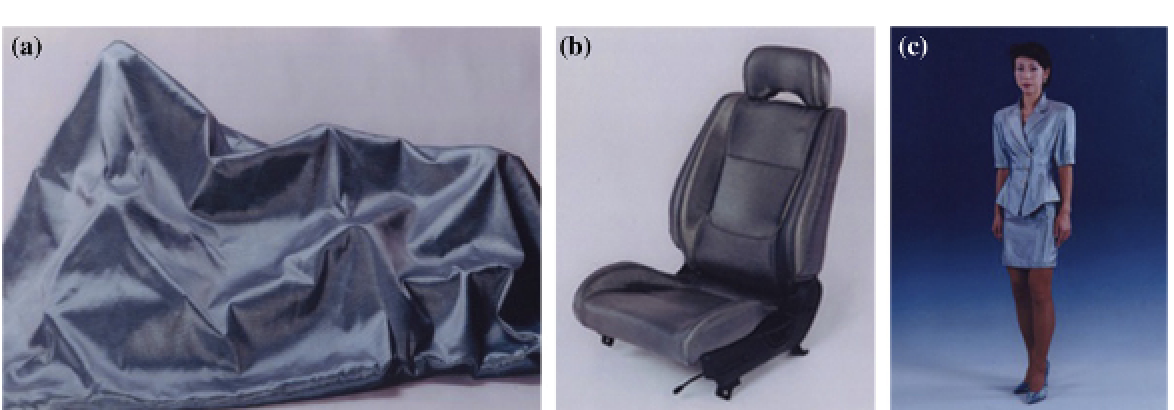Biomedical Engineering Reference
In-Depth Information
FIGURE 11.26
A fabric woven with the structurally colored fiber of Nissan Motor Co and applications thereof for
upholstery and dresses. Hiroshi Tabata, personal communication to ND (1999).
The granules themselves are not structurally
colored. They add the effect of scattering of white
light incident on them to the selective reflection
from the multilayered coaxial structure, thus
producing the final color and luster of the yarn.
Proper selection of the transparent and granular
substances can produce reflection peaks at wave-
lengths of about 480 nm, 550 nm, and 650 nm
and thereby exhibit vivid blue, green, and red
colors. The yarn has a circular cross-section and
is produced by the melt-spinning method, which
involves spinning the yarn at a temperature of
285 °C and a take-up velocity of 1,000 m/min
with the use of a single filament. After being
cooled and caked at room temperature, the yarn
has a diameter of about 40
μ
m.
Another technique for producing interference
colors on flat surfaces or fibers involves, again,
a dispersal of grains; however, the grains are
structurally colored and serve as an ink--a very
expensive one! A Bragg filter is deposited onto
a thin substrate, which is then granulated and
dispersed in a transparent polymer as ink. The
idea has been implemented for color-shifting
inks used on secure documents, currency,
stamps, credit cards, etc. Vapor deposition tech-
niques are commonly used for producing Bragg
ilters
[128]
. Also, layer-by-layer self-assembly
[115]
is used to make composite polymeric films
of specific composition and thicknesses in the
range of 5-1,000 nm with precision better than
1 nm
[129]
, particularly of large areas.
Inkjet printing of Bragg filters is very attrac-
tive because it is fast and inexpensive. For
instance, alternating sequences of tin oxide
(SnO
2
) nanoparticles (high refractive index) and
silica nanoparticles (low refractive index), both
overprinted with a cationic polymer (polyethyl-
eneimine), can be inkjet printed
[116]
. This
method is feasible for achieving bright structural
colors onto already produced textile fibers and
fabrics. However, further improvement is needed
to allow for regular smooth layers to be built up.
These methods demonstrate that the incorpo-
ration of structural colors in textiles could be a
very predictable, automated, and controlled
process. The mathematical model of interference
in periodic multilayered structures provides a
physical coloring recipe based only on the fol-
lowing physical parameters: the number of lay-
ers in the unit cell and the refractive index and
thickness of each layer. This recipe can precisely
forecast the coloration effect of fabrics and may
turn structural colors into a simple and inexpen-
sive alternative to dyed colors. Moreover, the
reflection color can be exploited for colorimetric
sensing, as discussed in Section
11.5.5
, thereby
proffering smart textiles in the near future.

